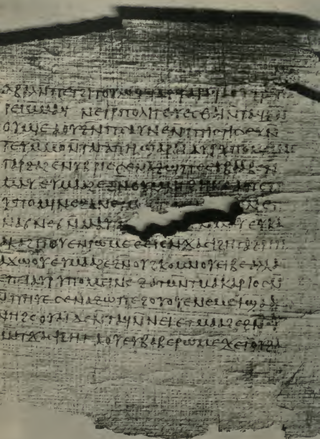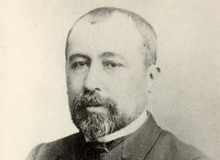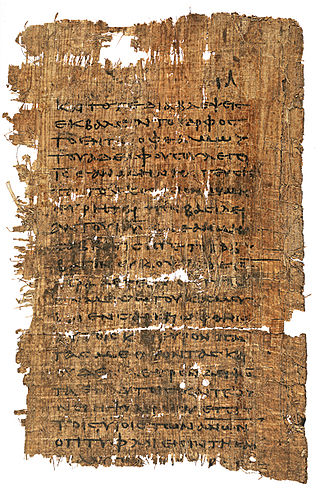
The Nag Hammadi library is a collection of early Christian and Gnostic texts discovered near the Upper Egyptian town of Nag Hammadi in 1945.
Pistis Sophia is a Gnostic text discovered in 1773, possibly written between the 3rd and 4th centuries AD. The existing manuscript, which some scholars place in the late 4th century, relates one Gnostic group's teachings of the transfigured Jesus to the assembled disciples, including his mother Mary, Mary Magdalene, and Martha. In this text, the risen Jesus had spent eleven years speaking with his disciples, teaching them only the lower mysteries. After eleven years, he receives his true garment and is able to reveal the higher mysteries revered by this group. The prized mysteries relate to complex cosmologies and knowledge necessary for the soul to reach the highest divine realms.

The Gospel of Mary is a non-canonical text discovered in 1896 in a fifth-century papyrus codex written in Sahidic Coptic. This Berlin Codex was purchased in Cairo by German diplomat Carl Reinhardt.
The Berlin Codex, given the accession number Papyrus Berolinensis 8502, is a Coptic manuscript from the 5th century CE, unearthed in Akhmim, Egypt. In Cairo, in January 1896, Carl Reinhardt bought the codex, which had been recently discovered, wrapped in feathers, in a niche in a wall at a Christian burial site. It was a papyrus bound book, dating to early 5th century that was written in Sahidic dialect of Coptic, which was in common use in Egypt during that time.

The Gospel of Judas is a non-canonical Gnostic gospel. The content consists of conversations between Jesus and Judas Iscariot. Given that it includes late 2nd-century theology, it is widely thought to have been composed in the 2nd century by Gnostic Christians. The only copy of it known to exist is a Coptic language text that has been carbon dated to 280 AD, plus or minus 60 years. It has been suggested that the text derives from an earlier manuscript in the Greek language. An English translation was first published in early 2006 by the National Geographic Society.

The Books of Jeu are two Gnostic texts. Though independent works, both the First Book of Jeu and the Second Book of Jeu appear, in Sahidic Coptic, in the Bruce Codex. They are a combination of a gospel and an esoteric revelation; the work professes to record conversations Jesus had with both the male apostles and his female disciples, and the secret knowledge (gnosis) revealed in these conversations.

The Epistle of the Apostles is a work of New Testament apocrypha. Despite its name, it is more a gospel or an apocalypse than an epistle. The work takes the form of an open letter purportedly from the remaining eleven apostles describing key events of the life of Jesus, followed by a dialogue between the resurrected Jesus and the apostles where Jesus reveals apocalyptic secrets of reality and the future. It is 51 chapters long. The epistle was likely written in the 2nd century CE in Koine Greek, but was lost for many centuries. A partial Coptic language manuscript was discovered in 1895, a more complete Ethiopic language manuscript was published in 1913, and a full Coptic-Ethiopic-German edition was published in 1919.
Codex Tchacos is an ancient Egyptian Coptic papyrus, which contains early Christian gnostic texts from approximately 300 AD: the Letter of Peter to Philip, the First Apocalypse of James, the Gospel of Judas, and a fragment of the Book of Allogenes.

The Bodmer Papyri are a group of twenty-two papyri discovered in Egypt in 1952. They are named after Martin Bodmer, who purchased them. The papyri contain segments from the Old and New Testaments, early Christian literature, Homer, and Menander. The oldest, P66 dates to c. 200 AD. Most of the papyri are kept at the Bodmer Library, in Cologny, Switzerland outside Geneva.

There have been many Coptic versions of the Bible, including some of the earliest translations into any language. Several different versions were made in the ancient world, with different editions of the Old and New Testament in five of the dialects of Coptic: Bohairic (northern), Fayyumic, Sahidic (southern), Akhmimic and Mesokemic (middle). Biblical books were translated from the Alexandrian Greek version.
The Askew Codex is a manuscript of parchment in quarto size, or 21 x 16,5 cm, held by the British Library, that contains Coptic translations of the Gnostic Pistis Sophia and parts of what G. R. S. Mead referred to as "extracts from The Books of the Savior."

Coptic literature is the body of writings in the Coptic language of Egypt, the last stage of the indigenous Egyptian language. It is written in the Coptic alphabet. The study of the Coptic language and literature is called Coptology.

Carl Gottfried Woide, also known in England as Charles Godfrey Woide, was an Orientalist, a biblical scholar and a pastor.

Émile Amélineau was a French Coptologist, archaeologist and Egyptologist. His scholarly reputation was established as an editor of previously unpublished Coptic texts. His reputation was destroyed by his work as a digger at Abydos, after Flinders Petrie re-excavated the site and showed how much destruction Amélineau had wrought.
Stephen Emmel is a Coptologist and musician.

Papyrus Oxyrhynchus 1 is a papyrus fragment of the logia of Jesus written in Greek. It was among the first of the Oxyrhynchus Papyri discovered by Grenfell and Hunt. It was discovered on the second day of excavation, 12 January 1897, in the garbage mounds in the Egyptian town of Oxyrhynchus. The fragment is dated to the early half of the 3rd century. Grenfell and Hunt originally dated the fragment between 150 and 300, but "probably not written much later than the year 200." It was later discovered to be the oldest manuscript of the Gospel of Thomas.

Nag Hammadi Codex II is a papyrus codex with a collection of early Christian Gnostic texts in Coptic. The manuscript has survived in nearly perfect condition. The codex is dated to the 4th century. It is the only complete manuscript from antiquity with the text of the Gospel of Thomas.
Carl Schmidt was a German Coptologist. He made editions of various Coptic texts, and was active in Egypt in purchasing papyri for German universities. He also assisted Sir Chester Beatty in his papyri purchases.
The Untitled Text in the Bruce Codex—also called the Untitled Treatise, the Untitled Apocalypse, and The Gnosis of the Light—is a Gnostic text. When James Bruce acquired the codex in Egypt in 1769, "very little knowledge" was available about this period of Gnostic Christianity. It was one of the few known surviving Gnostic works until the discovery of the Nag Hammadi library in 1945. Carl Schmidt described the text's author as having "full knowledge of Greek philosophy" and being "full of the doctrine of the Platonic ideas."












